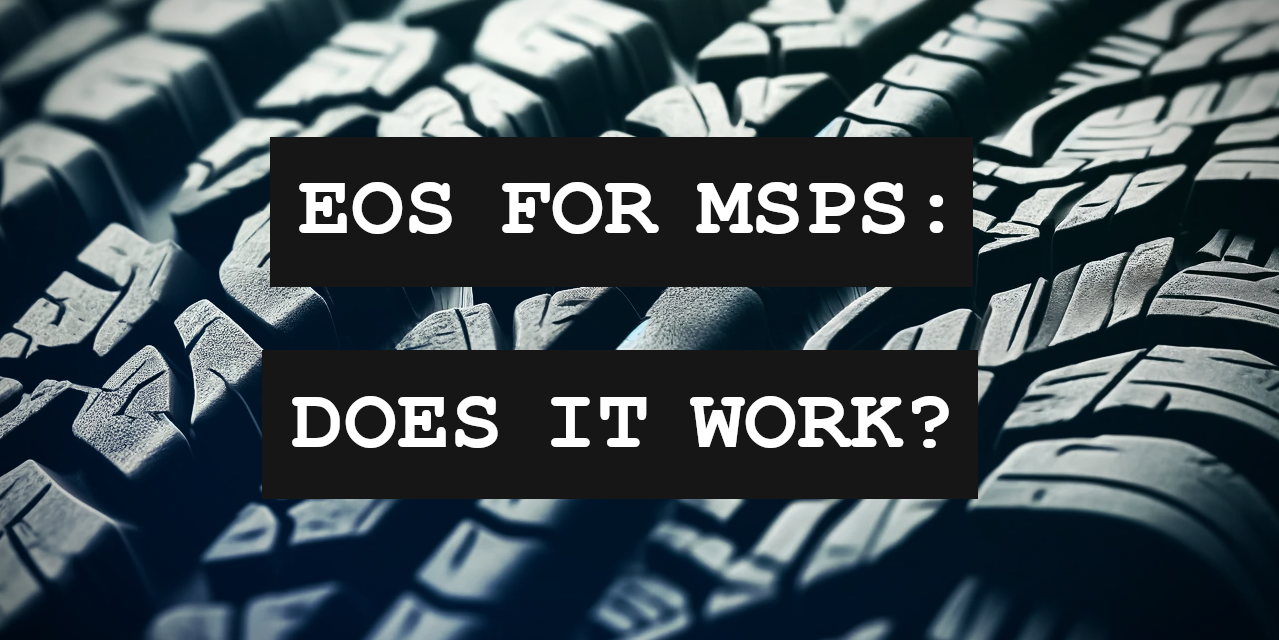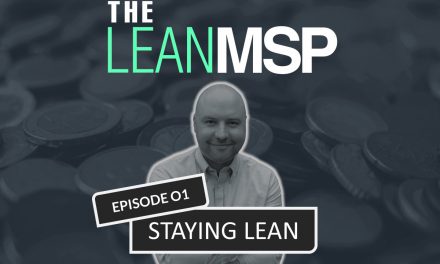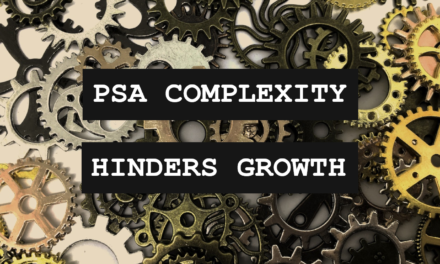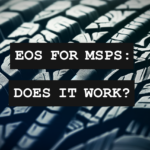EOS – Does It Work?
I want to start by saying that prior to two weeks ago, I knew almost nothing about EOS (Entrepreneurial Operating System). As someone who has been involved in mostly startups over the past decade, I have intentionally avoided out-of-the-box business systems such as these. In my experience, when you are a small team, you do whatever is necessary to survive and grow that day, week, month, etc. This is why I had always felt that systems are nothing more than corporate gimmicks pushed by influencers and often introduce constraints that are guaranteed to be broken.
Despite my initial (somewhat flawed) take, I recently had separate conversations with multiple MSP Owners that have decided to go “all-in” on EOS. Whenever something this coincidental occurs, I see it as a signal to start turning over rocks (no pun intended) and explore. Through this journey, I talked to as many MSPs and Consultants as I could find, to help me understand what the recent hype is all about and whether or not this system actually works. Afterall, EOS is not that new. Its origin story goes back almost 20 years, which was even more of a reason to be suspicious.
Here is what I learned and how this experience has reshaped my views on EOS and business systems in general:
The State of MSP & Cyber | 2024 IT Industry Report
Sponsored by Worklyn Partners & Zest
The IT / EOS Sub-Community
My first instinct was to create a survey and put it out on LinkedIn. To my surprise, it only took a few minutes for people to start chiming in, expressing their feelings toward EOS and tagging peers and colleagues for their input. I started to get the impression that this community of EOS Implementers and adopters in the IT industry might be larger than I’d expected. Each introduction that was made led me further towards people who I’ve never met with expertise that I didn’t know MSPs needed. Every one of these conversations was as fascinating as the next and they really helped me get a firm grasp on EOS itself and why it has grown such strong roots in the IT industry.
Like A Glove
There appears to be a somewhat unanimous consensus in the community regarding how well the EOS framework fits the MSP business model. As Bryan Lachapelle, President of B4 Networks Inc explains “Inside an MSP, we thrive when we improve incrementally over time. The annual and quarterly rhythm means we aren’t always chasing our tails, but actively working towards improving the overall systems and processes we use inside our MSP. Often we get down in the weeds, and forget to look at the bigger picture.”
He went on to say that “when you think about it, if all our clients also followed EOS, they would understand and want the Quarterly Business Reviews, and line it up to occur immediately after their internal Quarterly Meetings, so that we as their MSP can review their current quarterly objectives, and offer any advice as to what / where the MSP can assist with using technology where applicable. Better yet, have us at the strategy part of the quarterly.” I thought that this was a really great observation in the sense that many of the industry best practices (such as QBRs) map perfectly to EOS processes. While I don’t know the origin of every widely accepted best practice, I am starting to think that the parallelism may not be a coincidence.
Forking The System
Despite how well they appear to mesh together, there is apparently still room for optimization as it relates to installing a business OS in an MSP. As Brian Hoppe of Brian Hoppe Coaching explains, “The EOS framework can work really well for MSPs – I have seen several have success with it and unlock scale. However, there are a few aspects that can be difficult. I find that more regular meetings with the leadership team (every 6 weeks rather than quarterly) really helps to push the process forward, especially in the first year. We have created a framework similar to EOS specifically for MSPs which has proven successful.”
While changing the meeting frequency is a relatively slight deviation (a “fork in the code” if you will), some Consultants have decided to overhaul it completely. One of these people was Jamison West, CSO of both MSP+OS and TimeZest. “When EOS franchised, we chose to focus on our own Business Operating System, still based on the same thought leadership from the architects such as Lencioni, Sinek, Collins, and others. We wanted to have a system that was purely focused on the IT Services channel, with coaches that had real experience building and exiting their own IT business.” This is the mission that led West and company to merge with 4 other consulting businesses this year to form what is now called, MSP+OS.
Net Gains Achieved
While I loved hearing all of these stories, in my view the proof is always in the results. This is why I made sure to ask each participant what type of net gains they achieved that were a direct result of implementing EOS. In the case of Steve Van Dyk, Service Manager of EGLtech, he proclaims “We are seeing better communication as a Leadership Team and better cohesion as a business. Furthermore, everyone knows our stated trajectory and are better able to help achieve our goals.” In fact, many MSPs echoed a similar sentiment and attributed most of their strategic and cultural gains to the EOS framework.
But what about financial gains? I was not disappointed to hear several MSPs had increased performance in the year following their implementation. One example is Ian Groves, Managing Director of Start Tech, who claimed that they grew revenue from “800k to 2.2M turnover in 4 years, after 20 years [of doing business.]” The more of these stories I heard, the more convinced I became of the results. In many cases, the companies had been in business for over a decade with minimal growth, only to find their stride after installing an OS of some sort.
The Ultimate Guide To Cash Flow For Managed Services
Sponsored by Alternative Payments & Zest
Signs You Need An OS
I found it interesting that in many cases, EOS found the MSPs and not the other way around. By this I mean that many of them were not actively looking for a solution to a problem. They simply stumbled upon some form of resource that described the EOS philosophy and what it’s about. Suddenly, it clicked, and led them on a journey to self-improvement. So if you are reading this right now and are wondering “is this for me?” I will save you the serendipitous process of discovery.
Here are three key signs that experts agree would indicate that your business would benefit from an operating system:
Stagnant Growth
Growing an MSP requires stamina. Since this is not known to be a fast-growth business model, it leads many Operators to slowly grind it out year-after-year. This slow growth often lacks the enthusiasm that comes with other fast-growth startups, which can degrade a company culture over time. This has a direct impact on company performance and leads to lack of (or negative) growth over time.
Implementing a system such as EOS is a way to “wake up” the organization, visibly re-commit to growing the business, and bring the entire team together on a new path. While there are other ways to accomplish this as well, there are few that have such a proven track record and depth of resources in my opinion.
Lack of Vision
Another sign that your company may benefit from an operating system is if you are inconsistent in your decision-making. In many cases, this may indicate that your leadership team lacks a clear vision and thus your team is rarely performing optimally as a result. Afterall, if you don’t know where you are going, how can you find the best way to get there?
When asked about the benefits of EOS, Van Dyk also mentioned that it “keeps the focus on what is truly meaningful to the business vs. what is just a shiny object or distraction.” The word “focus” was a common theme that I heard throughout my conversations as it appeared that each of the organizations had a clear vision, and most importantly, they had a system in place to hold them accountable to that vision.
Failing To Transition
The transition from Technical Entrepreneur to a Business Leader and People Manager has always been difficult for MSP Owners. Scott Levy, CEO of ResultMaps said it best when he explained, “Founders often struggle to shift from ‘starting a company’ to ‘being a CEO.’ When you start a company, you are often doing everything you can in order to push the business to take off speed so it makes it off the runway and into the air. Once it’s off the ground, if you don’t shift being a CEO, you just get on a hamster wheel of trying to outwork the challenges. Vacations become little more than working from different locations while your family does activities without you.”
Given that the ResultMaps product enables the self-implementation of a wide range of business operating systems (regardless of industry), I found it really interesting how familiar Levy was with the MSP model and challenges therein. While this problem isn’t unique to the industry, it appears to be all too common. As I understand it, EOS is a proven way to force this transition and do so in a way that is not easily reversible. Whether it’s software, or a Certified EOS Implementer, there are a plethora of resources to grab onto to keep participants from falling back into old habits.
The State of MSP & Cyber | 2024 IT Industry Report
Sponsored by Worklyn Partners & Zest
Implementation Resources
I was surprised to find just how much “stuff” is out there to support the EOS journey. Some of this is clearly affiliated with EOS Worldwide (EOS’s governing organization), while others are “loosely-based” or “inspired-by” the framework’s principles. As I understand it, EOS Worldwide is tightening their grip on intellectual property, which has apparently also led them down the path of a franchising model. More on this later, but for now, here are some of the most recommended resources that I encountered through my conversations with MSPs:
Books
Books and written content appear to be the gateway for many to discover and take interest in EOS. As Bryan LaChapelle described, “Internally we read ‘Traction’ as a leadership team, then made all our team members read ‘What the heck is EOS?’. We started slowly by having the leadership team implement it first, and then when we were all comfortable, we started taking it to the departments.” While “Traction” was the most referenced book overall, there are many to choose from depending on the problems you are trying to solve and where you are in the implementation process.
To begin your journey, here are a few of the most notable books:
Software
If you are taking the DIY approach to EOS implementation, then tools are a necessity. As Jamison West put it, “Tools like Ninety.io or Strety are important to help keep everyone aligned. Self-implementation is not nearly as good, but might be necessary until you can afford an implementer. I believe a system like this works when you are as little as 2 people co-founding a business, then you grow with it, and the good habits you create. I strongly suggest a coach by the time you reach roughly 10 people.”
To aid in self-implementation, here are a few of the most recommended software apps:
Consultants
From the moment I raised the “EOS flag” on LinkedIn, I immediately got the attention of Consultants. It also didn’t take long for me to realize that some are official EOS Implementers (franchised), while others are Business Consultants who take inspiration from the framework. One of these individuals was Anne Schoolcraft, formerly a President of an MSP and now a Certified EOS Implementer for EOS Worldwide. As she explained, “We used an EOS Implementer. It was crucial to have an outside perspective in the room to really get clear and objective.” In my opinion, the fact that she went on to become an Implementer herself speaks volumes to the success of the program and value of the Consultants that uphold it.
For hands-on support, here are a few EOS Implementers and Consultants for MSPs:
- Anne Schoolcraft (EOS Worldwide)
- Dan Williams (EOS Worldwide)
- Jamison West (MSP+OS)
- Brett Jaffe (MSP+OS)
- Brian Hoppe (Brian Hoppe Consulting)
- Dave Cava (Encore Strategic)
- Shawn P. Walsh (Encore Strategic)
- Dave Casey (Mastery Partners)
The Ultimate Guide To Cash Flow For Managed Services
Sponsored by Alternative Payments & Zest
Common Points of Failure
Despite all of these resources at your disposal, there will be pitfalls. While some of those challenges will be unique to your organization, others are known issues and entirely preventable. Here are the top three most common points of failure that were described to me by the experts that I talked to:
Top-Heavy Adoption
Many MSPs and consultants that I spoke to mentioned that having leadership educate themselves and adopt the system first was the optimal starting point. That being said, this leaves organizations with an obvious pitfall, as some tend to think that full adoption is not necessary beyond that point or they simply fail to accomplish it.
This is what makes the books, software, and implementers so valuable, as they act as a means of distribution in an organization and provide the guardrails necessary to support the system over time. As many have pointed out, there are costs associated with adopting an OS, and therefore it’s important to protect that investment, even at the lowest rung on the organizational ladder.
Cherry-Picking The System
In the case of the EOS purists, they have largely agreed that cherry-picking the ideas without full implementation would often lead to a company failing to uphold the processes put in place. I found this to be incredibly interesting since others felt that this was actually a feature, and not a bug.
As Anne Schoolcraft put it, “It’s meant to be a complete system, and every piece supports every other piece. When a Visionary says ‘I’ll never need an Integrator,’ or a team says ‘We don’t need a scorecard,’ they end up hurting themselves. There is a level of commitment and faith required to really do the whole thing right.”
Lost In Translation
Another area of friction is the terminology. It didn’t take me long to realize that EOS has its own vernacular and without any prior understanding of it, it can be really confusing. I imagine Employees probably feel this way as well in the early days of their adoption of the program.
Scott Levy explained this really well. “EOS provides a clear path forward by standardizing language used for the different systems in the business. Presumably because change can be difficult, the system requires a lot of rules around the language that is used. There is a list of vocabulary terms for people to learn. Between this push to change language, the volume of terms, and then the perception that many of the terms are in place more to “brand” every day business ideas, well intended employees will sometimes disengage. There are ways to manage this, but I see people get it wrong.”
The State of MSP & Cyber | 2024 IT Industry Report
Sponsored by Worklyn Partners & Zest
Conclusion
While I still have a lot to learn about the actual EOS framework itself, I feel like I found the answer I was looking for to the question of “does this actually work?” To that I will say that there is enough evidence suggesting that EOS (or similar frameworks) might just be all they’re hyped up to be.
To save you even more reading (although you’ve made it this far) here is the TL;DR version of my conclusion based on two weeks of research:
Does it work? Yes. Installing a business operating system will help you grow.
Is it easy? No. The implementation process can be quite challenging.
Will it stick? Maybe. Only if you invest in the resources to keep it intact.
Am I too small? Probably Not. However the process varies based on org size.
Should I try it? Sure. Educate yourself first (Traction), then take it from there.

SPONSORED BY ZEST


















